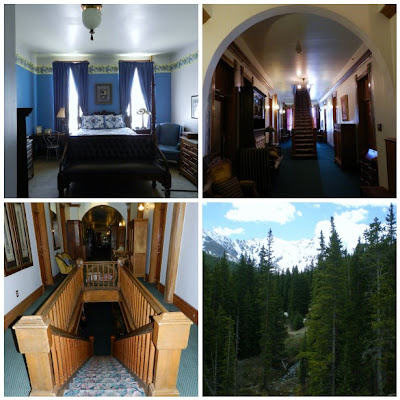Placer gold (gold that has weathered from the host rock where it was formed and is found atop the ground, in streams, etc.) was discovered in California Gulch in 1860, during the Pikes Peak Gold Rush. In 1874, gold miners discovered that the heavy black sand that impeded their gold recovery carried a high content of silver. Prospectors traced the source, and by 1876, had discovered several lode (a deposit in a rock formation, or vein) silver-lead deposits. The city of Leadville was founded near the new silver deposits in 1877, and by 1880, Leadville was one of the world's largest silver camps, with a population of over 40,000.
The city's fortunes declined with the repeal of the Sherman Silver Purchase Act in 1893, although afterwards there was another small gold boom. Mining companies came to rely increasingly on income from the lead and zinc. The district is credited with producing over 2.9 million troy ounces of gold, 240 million troy ounces of silver, 1 million tons of lead, 785 thousand tons of zinc, and 53 thousand tons of copper. WWII also caused an increase in the mining at the nearby Climax Mine, which at one time produced 75 percent of the world's molybdenum.
In it's heyday, the town boasted 150 saloons, 23 brothels and bordellos, and 15 churches. During WW11, 10th Mountain Division soldiers trained at nearby Camp Hale. A mecca for outdoor enthusiasts and history buffs, Leadville remains authentic and friendly, true to Colorado form.
One of the central figures in Leadville history is Horace Tabor. Horace and his wife Augusta, opened a grocery store in Leadville in 1868. He would later become the city’s first mayor and second postmaster. Known to be a generous man, Tabor was asked to “grubstake” two German immigrants in 1878 – he did…three times; the first costing him a mere $17.00. A month later, the Little Pittsburgh Mine hit, and by the end of summer, they declared a $10,000 dividend to each. Tabor quickly became the acknowledged leader of the silver mining community, and later bought, among others, the famous Matchless Mine.
(Photos of Baby Doe Tabor and Horace, in their heyday; Baby Doe at her opulent best; and Baby Doe on the streets of Denver, in later life).
(Above: Tabor Opera House; Tabor Grand Hotel with alcove where Baby Doe stood and awaited Horace's return each night. The Opera House was said to be the finest theater between St. Louis and San Francisco when it was built. It is open for tours during the summer months). When Congress repealed the Sherman Silver Act, the government was no longer in the market for silver and Horace, failing to listen to the advice of others and diversify, faced ruin. Tabor also had made a number of unsuccessful investments in foreign mining ventures, losing huge amounts of money in Mexico and South America. His reserves diminished, he and Baby Doe lost everything. Horace died a broken man in 1899.
The Delaware Hotel is the social hub, in the center of historic Leadville. The hotel, known as the “Crown Jewel” of Leadville, has remained an active part of Leadville history, and continues to represent the graciousness of the Victorian era. Erected in 1886 by the Callaway Brothers, as a monument to their home state. Baby Doe, who became a tragic figure after Horace’s death, lived alone at the Matchless Mine, and often visited the hotel to warm herself. She would climb the front entrance stairs, walk to the office and seat herself at the desk where she would write letters. Baby Doe’s feet were customarily wrapped in gunny sacks for warmth as she walked to town from her wooden shack.
Open for business year round, The Delaware is a member of the Historic Hotels of the Rockies. Reservations: 1-800-748-2004 ~ Office 719-486-1418; 700 Harrison Avenue, Leadville, CO 80461




















9 comments:
You should have taught history my friend. Your enthusiasm is contagious...
You can hear your love for your "home" <3
xx
z
Wow what a nice post. I have been to Leadvill many times but not in the past 25 years.
Nicole/Beadwright
We were in Leadville last summer and rode the Leadville train. We also shopped in a few stores there at ate at The Burro cafe. Our Son and family live in Buena Vista. Took many pics at Leadville. Love all the history you shared.
Ann
Wow! I love this history lesson! The town looks beautiful today. What a shame about Tabor and Baby Doe. Gotta watch that Karma!
I have been to the Leadville. There is a lot of scientific history to it as well. Grasses that have adapted to high lead content soil, pretty much as scientists watched, is among the biggest stories - demonstrating without a doubt that evolution occurs.
Thanks for the great, vicarious trip!
A agree you should have taught history. One of my favorite subjects in school, could never understand why others would daydream during class? You can learn so much about ourselves thru history. Fascinating stories.
So sad about what's gone on in CO today:(
hugs
C
I learn something new everytime I hang out with Tanya, she is a plethora of information! Yes, she should have been a teacher/professor for sure!! She missed her calling! Fabulous photos as always!
SO cool, Tanya! Great post!
Hugs,
Anne
I loved it all but especially loved the pictures!
Tanya-- oh my gosh-- this is a wonderful post- a great story- the photos are amazing. This would make a great story for a book or movie!! I think I'd love to visit there!!!!
Well done!!!
Vicki
Post a Comment